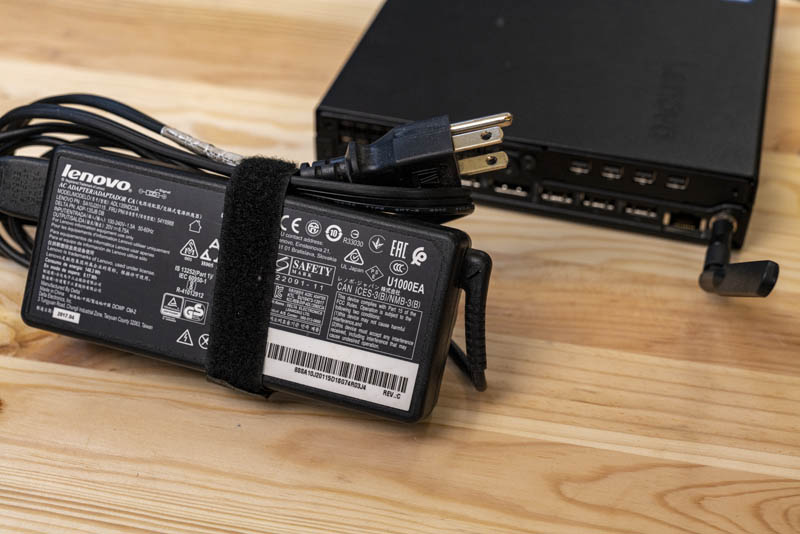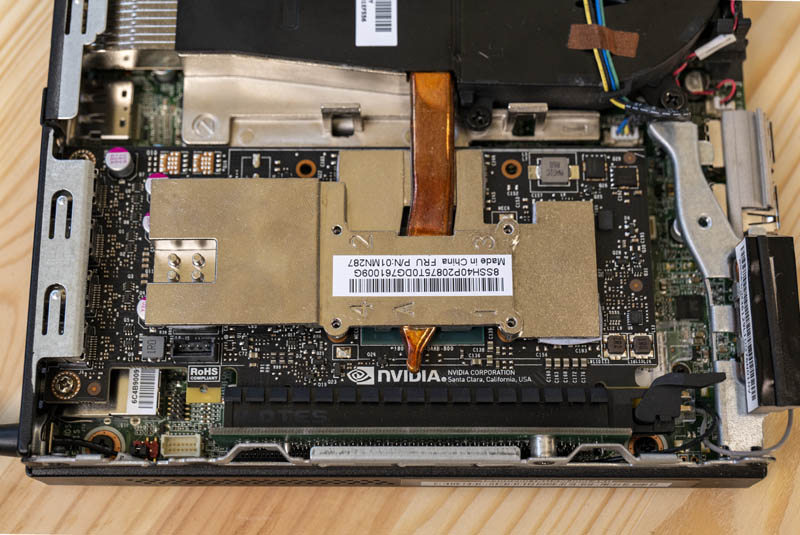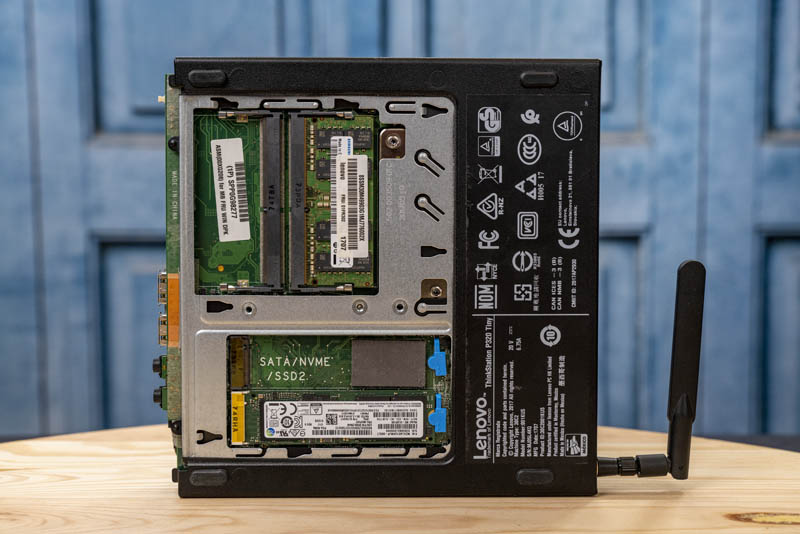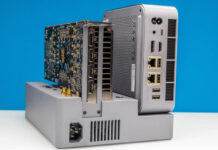Power Consumption
Idle power consumption on 120V power we saw 22-25W idle for the quad-core unit. We generally assume these nodes will use 9-12W idle but with the GPU and extra components, we would expect higher power consumption.

The power supplies are about 135W Lenovo power adapters from the company’s notebook line. We hit over 90W on our unit with the CPU and GPU working so power consumption is not insignificant under load. This is more than we see in non-GPU equipped Project TinyMiniMicro nodes.
At idle, the noise is not significant. Under CPU and/or GPU loads, the fan spins up and the system is very audible. An advantage is that one can move this system easily to avoid direct noise. This is a case where one could build a larger desktop that is as powerful or even more powerful with less noise. That system would also cost more, but if noise is the most important metric, and you plan to load the system heavily, then this is louder than many o the other units we have.
Next, we are going to discuss key lessons learned before getting to our final thoughts.
Key Lesson Learned for TMM
In this series, we wanted to also focus on some key lessons learned. Since we have already tested well over a dozen different models, we are taking away key pieces of advice from each that we wanted to share.

The key takeaway of this unit is that there are some options that cost a bit more, but also have a lot of the expandability that one may want. If you want more display outputs or even an NVIDIA GPU for some CUDA inferencing, then the P320 Tiny can be a great fit. In Project TinyMiniMicro, we are constantly pointing out design features that these systems have that some of the more build-your-own systems do not. While many involve serviceability, in this case, it is the tight integration of the NVIDIA Quadro P600 GPU with the heatsink and fan unit via the custom heat pipe cooler. This also shows an example of how these systems have the potential to be modified later, especially as 3D printing capabilities expand since one can easily see that GPU being replaced by a NIC in the future.

The SATA + NVMe configuration further showed how much can be done. We booted the system, for example, via an external USB SSD. Using that as an OS drive allows the system to have two internal higher-speed SSDs to drive performance storage. With the reasonably fast CPU, this opens new possibilities for TMM, albeit at a higher price point.
Final Words
We started Project TinyMiniMicro to focus on very low-cost nodes. To hammer that point home, we got the Project TinyMiniMicro HP EliteDesk 705 G3 Mini‘s for $200-225 off 3rd party sellers and the Dell OptiPlex 3070 Micro for $333 (with warranty.) At $505 this was at the higher-end of the budget. If we were just getting a Core i7 CPU with 16GB of memory and a 512GB SSD, it probably would not have been worth it. On the other hand, with the NVIDIA GPU we get something that is firmly in another class. That makes sense since Lenovo markets these systems as “workstation” systems instead of the corporate desktops many of the other units such as the Lenovo ThinkCentre M720q Tiny are marketed for.
Taking the system we had one step further, for about $55 we could add a second 16GB DDR4 SODIMM, and a second 512GB SATA SSD for $75. At a total of $630, we would have an Intel Core i7 4C/8T system with 32GB of memory and 1TB (2x 512GB) of SSD storage, and a Quadro GPU. A system like that is an excellent development server as well as a very capable desktop system.




Given the thermal throttling, it would be nice to include stress related heat measurements from the onchip sensors as well a direct measurement of the temperature of the air from the exhaust fans.
One thing I’m hoping for is a discussion of how to mount all these machines in a standard 19″ rack and replace all the separate power bricks with a single rack-level DC power supply. In my opinion, stuffing a bunch of power bricks into a confined space could reduce ambient cooling and turn them into fire bricks. If these mini PCs are going to be used as small servers, how to rack mount and power them may be an important consideration.
I managed to build 3x P320 proxmox ceph nodes in production env with 2 nvme osd and 64 Gb RAM, NViDIA P600 per node.
Proxmox OS sits on ssd thru tiny mb sata ports.
ram i think was single ch. mode by design.
Not necessary a fan of putting a display card there because throttling, and that if I have the price to go on full spec I might as well have the budget to poke with other SFFs that are also small and offers way better thermals. But since that’s the only 1L systems offering pcie slot (no pcie whitelists afaik), throw in a 10G card or something and use that as a core router might be a good way to go for homelabs… given one is willing to not put a shield there since its non standard
Lenovo do offer 4port i350 with shields though, though I’m not sure about pricing and availability in the NA.
I have toyed around with the idea of using USFF or SFF nodes.
But everytime i come to the conclusion, that for the same or even less money (in this very case of the reviewed unit), i can buy a uATX/ATX system that is much faster, much much more future proof, and not missing important parts.
Using a 7th Gen Core i7 when i get same cores/thread with 8th gen i3? With a upgrade option to 8/16 C/T?
Expanding networking (with Dual 1 Gbps NICs i can virtualize and additinal 10 Gbps nics)?
Throttling?
Later using a node e.g. for a NAS or other usecase where i need much more SATA/SAS?
Later using a node e.g. for GPU compute? As Gaming PC?
I can get a useable consumer grade Rack case for 60€. Useable mainboard for 60€-150€ depending on usecase, 40-50€ power supply. And then add what i need for the usecase from current generation product lines with later upgrade options.
The problem IMHO is with buying used gear now: Just a few years ago, Intel was forced to massively upgrade the cores/threads when the switched from 7th to 8th gen core because of AMD. Often doubling cores/threads in one generetional jump.
So i would prefer to wait until 8th gen core is being sold in these second hand markets, or prefer to build myself with new or used parts of Intel 8th Gen+ or AMD.
And being able to change the usecase
As always, nice article.
One typo on page 1.
“The chassis itself is a fairly standard design for the OptiPlex Micro series.”
……bit more info from my previous comment.
Proxmox OS on Half Slim SSD TS64GHSD370.
RAM 64Gb (2x32Gb) per node M471A4G43MB1-CTD
NVME (2x256Gb) MZVPW256HEGL-00000 or -000L7 per node.
Room temp. 23 Celsius
Idle temps for nvme in range: 46-52 celsius
Would it be possible to test some additional OSs on these nodes as you are going through them? Windows HyperV Server? ESXi?
I’ve actually collected a few of these Tinys over the years, from Atom & Pentium CPUs, to these workstation units. They make great low power devices for running core services in the homelab.
It’s worth noting that the M920q could be configured with an Intel I350-T4 quad-port GbE NIC, and I believe the bracket size and mounting holes should be the same. I don’t see any reason why it wouldn’t fit within a P320/P330 either.
In any case, the bracket for the I350 has a single rectangular hole, so you should be able to attach it to your favorite NIC (maybe an X710?) and chuck it into the P320.
Is it true that if you have a P600 model that you can only use 1 of the 2 NVME slots? Per the Lenov spec sheet @ https://psref.lenovo.com/syspool/Sys/PDF/ThinkStation/ThinkStation_P320_Tiny/ThinkStation_P320_Tiny_Spec.PDF
“Up to one 2.5″ disk drive (HDD or SSD) plus one M.2 NVMe SSD, or up to two M.2
SSD on Intel HD only models. Or up to one M.2 SSD on Quadro P600 models. 2nd M.2 SSD on Quadro P600 models is special bid only. 2.5″ drive cannot work with Quadro P600.
All US models come with Quadro P600 and only support M.2 SSD” Not sure what the “special bid only” means. Thanks!